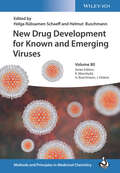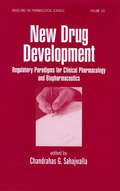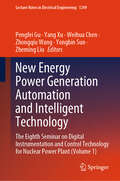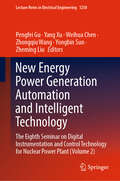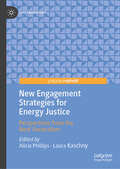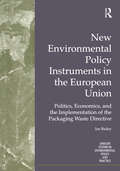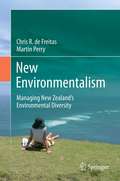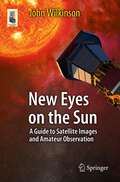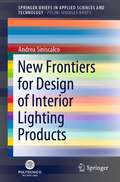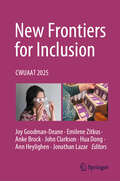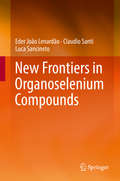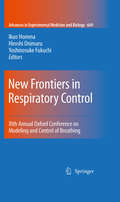- Table View
- List View
New Drug Development for Known and Emerging Viruses (Methods & Principles in Medicinal Chemistry)
by Raimund Mannhold Jörg HolenzDiscusses how to fight Ebola, SARS Corona, and other known or emerging human viruses by building on the successes in antiviral therapy of the past decades Written by leading medicinal chemists from academia and industry, this book discusses the entire field of antiviral drug discovery and development from a medicinal chemistry perspective, focusing on antiviral drugs, targets, and viral disease mechanisms. It provides an outlook on emerging pathogens such as Ebola, Zika, West Nile, Lassa, and includes a chapter on SARS Coronoavirus-2 causing the present pandemic. New Drug Development for Known and Emerging Viruses describes the discovery and development process for antiviral agents for different classes of viruses and targets based on the experiences from the nine human viruses for which approved drugs are on the market (HIV, HCV, Influenza, RSV, HBV, HPV, HCMV, HSV, and VZV). It covers the properties and potential of 20 classes of currently approved antivirals, including combination drugs, and looks at novel antiviral strategies against emerging viruses. Covers the entire field of antiviral drug discovery and development Addresses the need for antiviral drugs to combat major health threats such as Ebola, Zika, West Nile, and SARS Coronavirus-2 Summarizes the successes of the past 15 years in developing ground-breaking medicines against 9 major human viruses, both from the medicinal chemistry and the pharmacological angle Discusses practical and strategic challenges in the drug discovery and development process, including screening technologies, latency, and toxicity issues New Developments in Antiviral Drugs is an important book for medicinal chemists, pharmaceutical chemists, virologists, and epidemiologists, and will be of great interest to those in the ;pharmaceutical industry and public health agencies.
New Drug Development: Regulatory Paradigms for Clinical Pharmacology and Biopharmaceutics (Drugs and the Pharmaceutical Sciences)
by Chandrahas G. SahajwallaHighlighting key points from the latest regulatory requirements, New Drug Development helps those new to the world of pharmaceutical development understand regulatory steps, reduce cost by avoiding unnecessary trials, and attain guidance through each step of the drug approval process. This volume acquaints readers with procedures that determine the
New Dualities of Supersymmetric Gauge Theories
by Jörg TeschnerThis book reviews a number of spectacular advances that have been made in the study of supersymmetric quantum field theories in the last few years. Highlights include exact calculations of Wilson loop expectation values, and highly nontrivial quantitative checks of the long-standing electric-magnetic duality conjectures The book starts with an introductory article presenting a survey of recent advances, aimed at a wide audience with a background and interest in theoretical physics. The following articles are written for advanced students and researchers in quantum field theory, string theory and mathematical physics, our goal being to familiarize these readers with the forefront of current research. The topics covered include recent advances in the classification and vacuum structure of large families of N=2 supersymmetric field theories, followed by an extensive discussion of the localisation method, one of the most powerful tools for exact studies of supersymmetric field theories. The quantities that have been studied in this way are partition functions, expectation values of line operators, and supersymmetric indices. The book also reviews recently discovered connections between SUSY field theories in four dimensions and two-dimensional conformal field theory. These connections have a counterpart in relations between three-dimensional gauge theories and Chern-Simons theory; the book's closing chapters explore connections with string theory.
New Earth Histories: Geo-Cosmologies and the Making of the Modern World
by Dipesh ChakrabartyA kaleidoscopic rethinking of how we come to know the earth. This book brings the history of the geosciences and world cosmologies together, exploring many traditions, including Chinese, Pacific, Islamic, South and Southeast Asian conceptions of the earth’s origin and makeup. Together the chapters ask: How have different ideas about the sacred, animate, and earthly changed modern environmental sciences? How have different world traditions understood human and geological origins? How does the inclusion of multiple cosmologies change the meaning of the Anthropocene and the global climate crisis? By carefully examining these questions, New Earth Histories sets an ambitious agenda for how we think about the earth. The chapters consider debates about the age and structure of the earth, how humans and earth systems interact, and how empire has been conceived in multiple traditions. The methods the authors deploy are diverse—from cultural history and visual and material studies to ethnography, geography, and Indigenous studies—and the effect is to highlight how earth knowledge emerged from historically specific situations. New Earth Histories provides both a framework for studying science at a global scale and fascinating examples to educate as well as inspire future work. Essential reading for students and scholars of earth science history, environmental humanities, history of science and religion, and science and empire.
New Energy Power Generation Automation and Intelligent Technology: The Eighth Seminar on Digital Instrumentation and Control Technology for Nuclear Power Plant (Volume 1) (Lecture Notes in Electrical Engineering #1249)
by Yang Xu Weihua Chen Zheming Liu Pengfei Gu Yongbin Sun Zhongqiu WangThis book is the 1st volume of proceedings of the 1st Smart Nuclear Power Technology Forum and the 8th China Nuclear Power Plant Digital Technology and Application Seminar held in Shenzhen, China in June 2024. This seminar aims to explore the software and hardware of digital and instrument control (I&C) systems in nuclear power plants, such as inspection, testing, certification and research of sensors, actuators and control systems, and the application of electrical and intelligent operation and maintenance technologies. It aims to provide a platform for experts, scholars and nuclear power practitioners to exchange technology and share experience. At the same time, it also provides a platform for the combination of universities and enterprises in the aspects of production, education and research, and promotes the safe development of nuclear power plants. In addition, readers will encounter new ideas to achieve more efficient and safer instruments and control systems.
New Energy Power Generation Automation and Intelligent Technology: The Eighth Seminar on Digital Instrumentation and Control Technology for Nuclear Power Plant (Volume 2) (Lecture Notes in Electrical Engineering #1250)
by Yang Xu Weihua Chen Zheming Liu Pengfei Gu Yongbin Sun Zhongqiu WangThis book is the 2nd volume of proceedings of the 1st Smart Nuclear Power Technology Forum and the 8th China Nuclear Power Plant Digital Technology and Application Seminar held in Shenzhen, China in June 2024. This seminar aims to explore the software and hardware of digital and instrument control (I&C) systems in nuclear power plants, such as inspection, testing, certification and research of sensors, actuators and control systems, and the application of electrical and intelligent operation and maintenance technologies. It aims to provide a platform for experts, scholars and nuclear power practitioners to exchange technology and share experience. At the same time, it also provides a platform for the combination of universities and enterprises in the aspects of production, education and research, and promotes the safe development of nuclear power plants. In addition, readers will encounter new ideas to achieve more efficient and safer instruments and control systems.
New Engagement Strategies for Energy Justice: Perspectives from the Next Generation (Just Transitions)
by Alicia Phillips Laura KaschnyThis book offers an innovative exploration of energy justice, from concept to action, highlighting its role as a crucial tool for navigating the complexities of a just and sustainable energy transition. The book is timely and as the global energy transition rapidly progresses, it will serve as an essential resource, offering practical guidance to advancing a just and sustainable energy future. The perspectives presented in this book are presented by early career energy justice scholars from around the world, each highlighting and proposing ways to navigate the transition. The discussion focuses on three key themes: the integration and repurposing of energy infrastructures with the use of technology, the need for affordable and accessible energy services, and the promotion of responsible governance through effective policymaking and corporate social responsibility. At the heart of this book is the presentation of the ‘Toolkit to Achieve the Just Transition using the Energy Justice Framework’.
New Environmental Policy Instruments in the European Union: Politics, Economics, and the Implementation of the Packaging Waste Directive (Routledge Studies in Environmental Policy and Practice)
by Ian BaileyThe use of legislation by EU governments to define environmental standards for industry has been criticised for its poor track record in arresting the decline in the quality of Europe's environment. Environmental economists in particular have proposed that legislation should be supplemented or replaced by New Environmental Policy Instruments (NEPIs), such as eco-taxes, environmental charges, tradable permits and voluntary agreements. This book focuses on practical experiences with NEPIs in the EU and tests their application using the case study of the Packaging and Packaging Waste Directive. It traces the ways in which member states have adapted NEPIs to suit their preferred styles of environmental policy, then assesses their performance and how NEPIs have both assisted and hindered the EU environmental programme. It suggests options for ensuring that the environmental programme does not become fragmented by the use of NEPIs and discusses the implications of EU enlargement.
New Environmentalism
by Chris R. de Freitas Martin PerryThis book explains the role of New Zealand's environmental agencies and regulatory legislation, taking in the impact of international agreements and treaties. It traces the fortunes of sustainable policy approaches and analyzes the activities of the public agencies charged with managing the environment. Moving on to a detailed thematic status report on New Zealand's environment, it examines rural, freshwater, coastal, oceanic, atmospheric and urban zones. Finally, chapters detail public perceptions and normative environmental values as well as the depth of business commitment to environmental responsibility. An ideal introduction to the topic for a diverse range of scholars, the book eschews any specific theoretical framework in charting the recent evolution, current operation and future trajectory of environmentalism in New Zealand. It backs strategic advice with both social and ecological data, and raises questions over the country's reputation for greenness at the same time as recognizing its numerous achievements. With neat summaries of key issues at the end of each chapter, expansive guidance on further reading, and a multitude of examples ideal for classroom debate, this volume gives us an informed, objective, and wide-ranging appraisal on a topic of increasing centrality in the policy debate.
New Essays in Technical and Scientific Communication: Research, Theory, Practice
by Paul V. Anderson Carolyn R. Miller R. John BrockmannNew Essays in Technical and Scientific Communication represents the most important collection of writings about technical communications ever compiled. Focusing on a wide range of theoretical and practical issues, these essays reflect the rigor, vitality, and interdisciplinary nature of modern technical communications. This represents a collection of the very best scholarly work being done.
New Eyes on the Sun
by John WilkinsonInformation collected by satellites recently sent by the USA, the European Space Agency, Japan, Germany, the United Kingdom, and Russia to monitor the Sun has changed our knowledge and understanding of the Sun, particularly its effect on Earth. This book presents these findings in a way that will be welcomed by amateur astronomers, students, educators and anyone interested in the Sun. Enhanced by many colour photographs, the book combines newly acquired scientific understanding with detailed descriptions of features visible on the Sun's surface and in its atmosphere. In the past, observing the Sun has been left to academics with specialised instruments, since solar observation has been unsafe because of the risk of eye damage. This book explains how amateur astronomers can safely observe the various solar phenomena using special hydrogen-alpha telescopes that are not too expensive. Amateurs can now make a positive contribution to science by monitoring the Sun as professionals do. Amateurs can also access the solar images taken by satellites via the internet. This book helps readers interpret and understand what these images are showing about the Sun, including the latest 3D images. Solar observers will enjoy comparing their own solar telescope observations with those produced by space probes such as SDO, SOHO, Hinode and STEREO, and further enjoy learning about transits, eclipses, and space weather and how the Sun compares to other stars in the universe. The main purpose of this book is to present some of the fascinating solar phenomena in their full splendor to readers through a variety of illustrations, photographs and easy to understand text.
New Flora of the British Isles
by Clive StaceSince its first publication in 1991, New Flora of the British Isles has become established as the standard work on the identification of the wild vascular plants of the British Isles. The Flora remains unique in many features, including its full coverage of all British wild plants, its user-friendly organisation, and its specially compiled keys and descriptions. This new edition includes the addition of more than 160 species, so that 4,800 taxa are now covered in varying degrees of detail. It also incorporates the new molecular system of classification based on DNA sequences. Furthermore, it includes 1600 species illustrations, rewritten distributions and an overhaul of the designation of degrees of rarity, with the introduction of a third, less rare, category. These revisions should ensure that this third edition remains the essential reference source for all taxonomists, ecologists, conservationists, plant hunters and biogeographers, whether they be researchers, teachers, students or amateurs.
New Forms of Urban Agriculture: An Urban Ecology Perspective
by Harpreet Kaur Jessica Ann DiehlEating locally and developing an urban-rural food continuum is a rapidly evolving movement. Integration of multi-functional forms of agriculture — termed New Forms of Urban Agriculture (NFUA) — could be a critical adaptation to strengthen this movement and for the sustainability of cities. While NFUA have the potential to provide diverse benefits to humans, there is an absence of reliable empirical data on the scale and impact of urban resources on NFUA which has a profound impact on its viability and sustainability. In this book, we shift the focus from how NFUA have potential to impact the urban system to investigate the potential impacts of urban resources on NFUA. Access to resources such as land, labour, clean water, etc. are major barriers to enter the agriculture sector in the cities; the chapters in this book present projects or reviews recent research on the subject from different cities in the world. This edited volume offers critical perspectives from diverse disciplines, expertise, and geographic contexts related to the actual and potential role of urban and peri-urban agriculture in the developing and the developed world where forms, adaptations, and debates around NFUA vary distinctively. Using and urban ecology lens, the book provides empirical evidence of how urban resources of land, water/waste, labour, and biodiversity impact NFUA.
New Frontiers for Design of Interior Lighting Products (SpringerBriefs in Applied Sciences and Technology)
by Andrea SiniscalcoThis book explores the single components that commonly constitute luminaires for interiors, describing their operating principles, families, strengths and weaknesses. It opens with the product classification and main standard requirements. The following chapters describe the different components: light sources, power supplies, thermal dissipation techniques, control technologies, optical systems. The description focuses on the most recent technologies to allow the reader to consider a product design capable of confronting future lighting scenarios. The book provides a simple path addressed to all those who want to try their hand at designing luminaires for interiors, even without a specific engineering background.
New Frontiers for Inclusion: CWUAAT 2025
by John Clarkson Jonathan Lazar Ann Heylighen Hua Dong Joy Goodman-Deane Emilene Zitkus Anke BrockThis book presents papers from the 12th Cambridge Workshop on Universal Access and Assistive Technology (CWUAAT 2025), to be held in April 2025. This workshop series has hosted the multifaceted dialogue on design for inclusion since 2002, involving disciplines including design, computer science, engineering, architecture, ergonomics and human factors, policy and gerontology. The conference theme for 2025 is New frontiers for inclusion. The major themes dealt with in this collection include: Understanding people Designing for an ageing population Designing for particular needs Designing inclusive environments New challenges and opportunities the possibilities and challenges for inclusive design offered by AI and other emerging technologies. With its thematic wealth, this proceedings provides a unique insight into the current national and international research in the fields of inclusive design, universal access, and assistive and rehabilitative technology.
New Frontiers in Cryptography: Quantum, Blockchain, Lightweight, Chaotic and DNA
by Khaled Salah MohamedThis book provides comprehensive coverage of various Cryptography topics, while highlighting the most recent trends such as quantum, blockchain, lightweight, Chaotic and DNA cryptography. Moreover, this book covers cryptography primitives and its usage and applications and focuses on the fundamental principles of modern cryptography such as Stream Ciphers, block ciphers, public key algorithms and digital signatures. Readers will gain a solid foundation in cryptography and security. This book presents the fundamental mathematical concepts of cryptography. Moreover, this book presents hiding data techniques such as steganography and watermarking. The author also provides a comparative study of the different cryptographic methods, which can be used to solve security problems.
New Frontiers in Environmental Toxicology
by Tanu JindalThis volume provides up-to-date information on toxic pollutants in the environment and their harmful effects on human health and nature. The book covers many important aspects of environmental toxicology, such as features, characterization, applications, environmental routes for dispersion, nanotoxicity, ecotoxicity and genotoxicity of nanomaterials, with emphasis on radiation toxicology, polar ecotoxicology, plastic toxicology, microbrial toxicology, nanotoxicology and pesticide toxicology. Also discussed is the use of microbes and nanotechnology for medicinal purposes, which has revealed important chemical prototypes in the discovery of new agents, stimulating the use of refined physical techniques and new syntheses of molecules with pharmaceutical applications for human welfare. The chapters also address the fate of nanoparticles in the environment, as well as nanotoxicology mechanisms impacting human health. The book will be of interest to toxicologists, environmental scientists, chemists, and students of microbiology, nanotechnology and pharmacology.
New Frontiers in GRMHD Simulations (Springer Series in Astrophysics and Cosmology)
by Cosimo Bambi Yosuke Mizuno Swarnim Shashank Feng YuanThis book offers an updated comprehensive review of the rapidly expanding field of GRMHD simulations. In Part I, it reviews the basic equations for GRMHD simulations and for numerical relativity. Part II describes public codes for GRMHD simulations. Part III is devoted to accretion processes onto compact objects in the non-self-gravitating fluid approximation. Part IV reviews the state of the art of GRMHD simulations with self-gravitating fluids. This book represents both a valuable book for graduate students and important reference resource for researchers in the field.
New Frontiers in Gravitational Collapse and Spacetime Singularities (Springer Series in Astrophysics and Cosmology)
by Pankaj S. Joshi Daniele MalafarinaThe book collects a series of articles to review the advances that have been made in the field of gravitational collapse in general relativity and alternative theories of gravity in the past few years. Many approaches to black hole and singularity formation in general relativity and beyond have been proposed over the last few decades. The importance of collapse models is that they provide natural thought experiments where to test the behavior and properties of a variety of approaches to general relativity and its implications for ultra-compact objects in the universe.
New Frontiers in Organoselenium Compounds
by Eder João Lenardão Claudio Santi Luca SancinetoThis book presents recent advances in and perspectives on the use of organoselenium compounds, primarily highlighting the new frontiers in the field of Green Chemistry, their therapeutic and biological relevance and new materials. Throughout its 200 pages, readers will find an updated and comprehensive review of new aspects of organoselenium chemistry and biochemistry. Fully referenced and written in an easy to read style, it offers readers a primary resource for including organoselenium derivatives in their projects. This book will be of interest to specialists, students and researchers involved in a broad range of fields, from synthetic green chemistry to medicinal chemistry and the chemistry of natural products. The connection between organoselenium compounds and green chemistry, despite having only recently emerged, is one of the subjects of this book. The first chapter highlights the use of Se-containing molecules as reagents and catalysts in new green protocols to access important organic transformations. The book provides a wealth of examples of bioactive Se-containing molecules, especially focusing on those with potential therapeutic uses. The second chapter focuses on the state of the art concerning the role of organoselenium compounds as antioxidants, GPx mimics, and derivatives endowed with different bioactive properties. “Organoselenium in nature” is the title of the third chapter, which equips readers with essential information on the main natural organoselenium compounds and where they are found. Selected aspects of the metabolism of selenium in plants and microorganisms are also discussed. In closing, the book includes a chapter dedicated to recent advances concerning the nonbonding interactions between organochalcogen compounds. This is currently a hot topic in selenium chemistry and biochemistry, and here readers will find key insights into the chalcogen bond and its role in the biological activity of organoselenium compounds.
New Frontiers in Pediatric Traumatic Brain Injury: An Evidence Base for Clinical Practice (American Academy of Clinical Neuropsychology/Routledge Continuing Education Series)
by Vicki Anderson Keith Yeates Cathy Catroppa Miriam BeauchampNew Frontiers in Pediatric Traumatic Brain Injury provides an evidence base for clinical practice specific to traumatic brain injury (TBI) sustained during childhood, with a focus on functional outcomes. It utilizes a biological-psychosocial conceptual framework consistent with the International Classification of Functioning, Disability and Health, which highlights that biological, psychological, and social factors all play a role in disease and children’s recovery from acquired brain injury. With its clinical perspective, it incorporates current and past research and evidence regarding advances that have occurred in outcomes, predictors, medical technology, and rehabilitation post-TBI. This book is great resource for established and new clinicians and researchers, graduate students, and postdoctoral fellows who work in the field of pediatric TBI, including psychologists, neuropsychologists, pediatricians, and psychiatrists.
New Frontiers in Photochromism
by Masahiro Irie Takahiro Seki Yasushi YokoyamaPhotochromism is the reversible phototransformation of a chemical species between two forms having different absorption spectra. During the phototransformation not only the absorption spectra but also various physicochemical properties change, such as the refractive index, dielectric constant, oxidation/reduction potential, and geometrical structure. The property changes can be applied to photonic equipment such as erasable memory media, photo-optical switch components, and display devices. This book compiles the accomplishments of the research project titled "New Frontiers in Photochromism" supported by the Ministry of Education, Culture, Sports, Science and Technology of Japan. The project focused not only on the above-mentioned classical subjects in photochromism, such as color changes, optical memory, and optical switches, but also on fundamental physicochemical studies and unprecedented application fields that have not yet been explored in photochromism. The latter topics include light-driven mechanical motion, photocontrol of surface wettability, metal deposition on solid materials, photocontrol of chiral properties, ultrafast decoloration dyes, and femtosecond laser experiments, among others.
New Frontiers in Plant-Environment Interactions: Innovative Technologies and Developments (Environmental Science and Engineering)
by Tariq AftabThis book provides information about plant–environment studies and challenges for plant improvement to achieve food security. Plants face a wide range of environmental challenges, which are expected to become more intense as a result of global climate change. Plant–environment interactions play an important role in the functioning of ecosystems. There are habitats throughout the world that present challenges to crop plants, such as through a lack of water and excessive, or toxic, salts in the soil. Soil properties represent a strong selection pressure for plant diversity and influence the structure of plant communities and participate to the generation and maintenance of biodiversity. Plant communities selected by environment grow by modifying soil physical, chemical, and biological properties, with consequent effects on survival and growth of plants. The complexity of plant–environment interactions has recently been studied by developing a trait-based approach in which responses and effects of plants on environment were quantified and modeled. This fundamental research on plant–environment interaction in ecosystems is essential to transpose knowledges of functional ecology to environmental management. Plants have adapted to an incredible range of environment, and extensive researches on ecological and environmental plant physiology have provided mechanistic understanding of the survival, distribution, productivity, and abundance of plant species across the diverse climates of our planet. Ecophysiological techniques have greatly advanced our understanding of photosynthesis, respiration, plant water relations, and plant responses to abiotic and biotic stresses, from instantaneous to evolutionary timescales. Ecophysiological studies also provide the basis for scaling plant physiological processes from the tissue to the canopy, ecosystem, region, and to a large extent, the entire globe. Given the above, the author proposes to bring forth a comprehensive book, “New Frontiers in Plant-Environment Interactions”, highlighting the various emerging techniques and applications that are currently being used in plant–environment interaction research and its future prospects. The author is sure that this book caters the need of all those who are working or have interest in the above topic.
New Frontiers in Respiratory Control
by Hiroshi Onimaru Ikuo Homma Yoshinosuke FukuchiThe Oxford Conference has been first held at Oxford University in 1948. Since then, it has been held every three years in various countries to exchange ideas and learn the latest findings on the control of respiration. The XIth Oxford Conference will focus on respiratory control, especially on the topics of respiratory rhythm generation and chemoreception. Clinical research on sleep apnea syndrome will also be an important subject at the meeting.
New Frontiers in Science in the Era of AI
by Vittorio Gorini Marilena Streit-BianchiThis interdisciplinary book enables scientists and non-specialists from various fields to delve into fascinating historical and recent scientific advancements in physics, astrophysics, genetic evolution, neuroscience, and artificial intelligence. Paradigm shifts are common in science, but some have significantly changed our perception and understanding of the world. This volume not only explores the profound implications of these scientific frontiers but also forecasts their impact on daily life. It delves into ongoing research and the technology that fuels advancements in physics and related fields. Authored by renowned researchers and science communicators, this book appeals to researchers and non-experts seeking a comprehensive overview of emerging developments that challenge ongoing research and will impact education and society in the coming years. Structured into distinct sections - New Physics World, Evolutionary Genetics to Epigenetics, Neurosciences and Neurophilosophy, Applications of Artificial Intelligence, and The Mystery of the Dark Sector - each chapter provides a deep dive into its respective subject, shedding light on the mysteries and implications of cutting-edge science. The book ends with an Epilogue illustrating the limitations of and challenges for our cognitive abilities.
